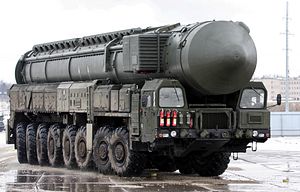Russia is hoping to develop a hypersonic weapon system capable of penetrating advanced missile defense systems by the early 2020s, according to a senior Russian defense official.
The head of Russia’s Tactical Missile Corporation, Boris Obnosov, said in an interview with Pravda that his company is working in close cooperation with scientists from the Russian Academy of Science and the Advanced Research Foundation under the Military-Industrial Commission to field a hypersonic weapon system within the next couple of years.
Furthermore, Obnosov explained that the current weapon systems under development are based on Soviet-era Kholod and Kholod-2 hypersonic rockets as “it would be impossible to create such weapons from scratch, although technologies at the necessary level are available.” He also reiterated that Russia needs to invest more resources into research and field experiments.
Russia is considered to be behind China and the United States in developing hypersonic weapon systems. Russia has repeatedly tested a new hypersonic glide vehicle (HGV), dubbed Yu-71, over the last two years. The last successful test occurred in April 2016, according to Pentagon officials. (A previous test in June 2015 was deemed unsuccessful.)
As I reported previously (See: “Russia’s Secret New Weapon: Should the West Be Afraid?”), past tests have taken place at the Dombarovsky missile base in eastern Russia. They involved the launching of a SS-19 intercontinental ballistic missile on which the HGV warhead is mounted. Once the missile reaches the boundary between space and the Earth’s atmosphere–approximately 100 kilometers above the ground–the HGV is released.
As I further explained:
Once it reaches near space and is ejected from the missile booster, the Yu-71 HGV begins to glide in a relatively flat trajectory by executing a pull-up maneuver and accelerating to up to ten times the speed of sound, or around 7,680 miles per hour.
The gliding phase enables the Yu-71 HGV not only to maneuver aerodynamically – performing “extreme maneuvers” and evading interception – but also extends the range of the missile.
Hypersonic weapons are thought to be capable of penetrating any existing missile defense system based on interceptor missiles, I noted:
[U]nlike conventional reentry vehicles, which descend through the atmosphere on a predictable ballistic trajectory, hypersonic glider vehicles are almost impossible to intercept by conventional missile defense systems, which track incoming objects via satellite sensors and ground and sea radar.
One of the principal technical problems consists of developing a control system for the HGV, according to a Russian defense industry source. “At a speed of Mach 5, a cloud of plasma develops around the object that does not let radio beams through. That is why if the missile deviates from its trajectory or there are any other problems during the flight, operators are yet unable to rectify the situation remotely,” the source told RBTH.
According to a Russian military expert interviewed by RBTH, various Russian missile warheads can already accelerate to hypersonic speeds when they are approaching their targets. “These are warheads of the Yars and Rubezh long-range missile systems, which in the final stretch of their flight start maneuvering at a hypersonic speed to overcome the enemy’s missile defense system. The warhead of the Iskander-M short-range missile has the same capability too,” the military expert said.
































